Cajamarca is the capital of the Cajamarca region of Peru. It is an ancient city, with roots dating back three thousand years, making it a fascinating travel destination for lovers of history, culture, and art.
Before the colonialist era, before the Inca era, and even before the Chavín peoples, Cajamarca was inhabited by the Huacaloma, Layzón, Cumbe Mayo y Otuzco peoples.
Cajamarca lies approximately 150 mi. (241 km) south of Ecuador and 75 mi. (121 km) east of the Pacific Coast in the highlands of northern Peru. It is surrounded by fertile lands in a valley bordered by the Andes mountains.
Just 9 mi. (14 km) to the north of Cajamarca lies the second largest gold mine in the world, the Yanacocha mine. This open pit mine, which is run by the Denver, Colorado based Newmont Mining Corporation, has caused controversy in the region as a result of contamination of the water and air.

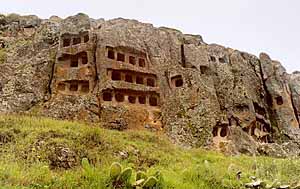
Trivia & Quick Points
- Cajamarca had 188,363 residents, according to the 2007 census.
- Cajamarca has a subtropical highland climate, with very consistent high temperatures of 70-72°F (21-22°C) year-round and lows of 37-45°F (3-7°C).
- Cajamarca receives little rain, with the highest average rainfall of 4.3 in. (11 cm) in March and a very dry summer.
- The most important sectors of Cajamarca’s economy are ranching, mining, and agriculture.
Facts & Information
History:
Remnants of the ancient history of Cajamarca can be seen in petroglyphs, ancient aqueducts, and other stone carvings in Cajamarca and beyond. These civilizations date back three thousand years and include the Huacaloma, Layzón, Cumbe Mayo y Otuzco peoples.
Around 1450, Cápac Yupanqui, the brother of Pachacútec, conquered Cajamarca and annexed it to the Inca Empire.
In 1532, Francisco Pizarro led Spanish Conquistadors in the battle that ended the Inca Empire. Atahualpa, the Incan leader, expected to meet Pizarro and his men peacefully in the Plaza de Armas in Cajamarca. He left most of his army of tens of thousands outside the city and entered the city with an entourage of men carrying only knives or small axes.
Pizarro’s small army hid in buildings in the plaza, which had been vacated prior to Atahualpa’s arrival. Friar Vincente de Valverde, approached Atahualpa, gave him a bible, and demanded his acceptance of Catholicism. Atahualpa dropped the bible on the ground.
Pizarro then led his men into the plaza, shooting at Atahualpa’s entourage. Atahualpa was captured and imprisoned. Atahualpa offered a ransom of gold and silver in exchange for his freedom. Pizarro accepted the gold and silver, but reneged on the agreement, killing Atahualpa. With Atahualpa dead, Pizarro led his men south to Cuzco to conquer the Inca Empire.
In Cajamaraca, the Spaniards redeveloped the city. An Inca temple adjacent to the Plaza de Armas was converted into a Catholic church dedicated to St. Francis. In the 17th and 18th centuries, additional churches and cathedrals were built. The most significant are the Cathedral of Cajamarca, the Church of Belén, the Recoleta Church, and the Chapel of the Virgen de los Dolores.
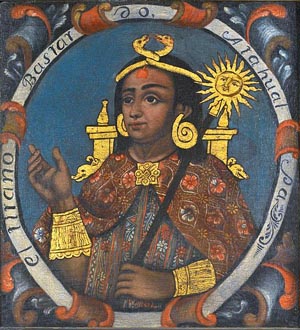
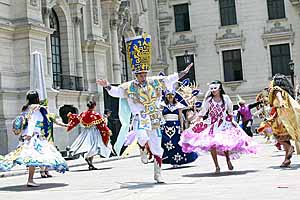
Culture
Archaelogists have uncovered traces of the pre-Incan cultures throughout the Cajamarca region. These include the necropolis of Otuzco, known as the Ventanillas (small windows) of Otuzco, where tombs were dug in a hillside; enclosures with stone hearths, which were used for religious rituals; petroglyphs and aqueducts at Cumbe Mayo.
Remnants of the Inca culture can be seen in the Inca baths, located just a few miles to the northeast of Cajamarca. These baths were hot springs that the Inca built into a bathing complex.
The building in which Atahualpa offered the ransom of gold and silver to Pizarro and the Spanish conquistadors remains in Cajamarca and is known as the Cuarto del Rescate (Ransom Room).
Modern day Cajamarca is known for its colorful Carnaval celebration held in the three weeks prior to Lent. The Carnaval is celebrated with music, food and drinks, parades with floats and people in vibrant costumes,and the water and paint games, in which festival goers throw water at a procession of painted people.
Travel & Tourism
Cajamarca is surrounded by sites of archeological significance from the Inca Empire and cultures pre-dating the Incas. It also boasts stone cathedrals with an architecture distinct from other cities of Peru.
Highlights & Features of the City and Surroundings:
- The focal point of the city of Cajamarca is the Plaza de Armas. It has been remodeled over the years, but in its center is a fountain, which is where Atahualpa was killed by Pizarro and his conquistadors. The Plaza, with its grassy park setting is enjoyed by Cajamarca residents and tourists alike.
- The Santa Apolonia hill, which lies about 218 yards (200 m) to the south of the Plaza de Armas, not only offers expansive views of the city and the surrounding valley, but is also home to stone carvings known as the ‘Seats of the Inca’, though they were actually altars built by more ancient civilizations.
What to Do & See
- Cathedral of Cajamarca
The Cathedral of Cajamarca was constructed between 1682 and 1762. The Spanish basilica plan was used, and the (still unfinished) facade, made from volcanic rock, was embellished with carvings of cherubs, birds, grapevines and pomegranates.The cathedral is one of the best examples of Peruvian baroque architecture. Inside are paintings of the Virgen del Carmen, Santa Rosa de Lima and San Martín de Porres and an altar decorated with gold leaf. - The Church and Convent of San Francisco, which lies next to the Plaza de Armas, was constructed from stone excavated from the Santa Apolonia hill. The construction began in 1699 and continued throughout the 18th century. The architecture is Baroque Plateresque. Visitors to the Church of San Francisco can also enjoy the religious art in the church’s museum.
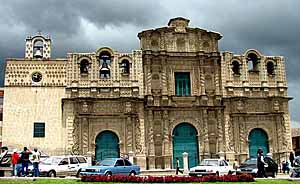
- Four blocks southeast of the Plaza de Armas is the Church of the Recoleta. Built in the 18th century, this church and convent was ransacked by Chilean troops in the War of the Pacific.
- The Church of Belén, built in the 18th century in colonial baroque architecture, is located one block south of the Plaza de Armas. Its cupola is decorated with religious scenes and, through its windows, brings light into the church.
- The Church of the Concepción (known as the Church of Nuns in Cajamarca) was finished in 1806 and built of volcanic stone in the neoclassic style. Its interior and altar are richly decorated with statues and carvings in wood, stone, and bronze.
- One half block southeast of the Plaza de Armas lies the Cuarto de Rescate (Ransom Room), where Atahualpa was imprisoned for over eight months. Atahualpa presented Pizarro with a room full of gold and twice filled with silver as his ransom, but Pizarro killed Atahualpa in the end.
- Huacaloma, located 2 mi. (3.5 km) southeast of the city center, is the site of ancient stone ruins. Here, the remains of a temple complex dating back to 1500 b.c., can be seen. The temples were converted to residences during the latter period of use around 500 b.c., when they were covered with yellow earth, and terraces were built on top of them.
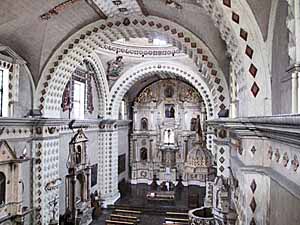
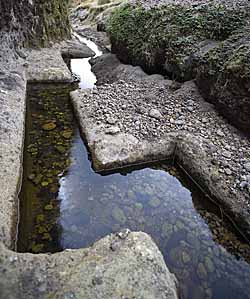
Sightseeing Excursions from Cajamarca
- Cumbe Mayo is the site of a ‘stone forest’ known as ‘los frailones’ due to its resemblance to a group of pious friars. Here one also finds an extensive stone aqueduct built by Cajamarcans 1000 years before Christ and ancient petroglyphs that include maps and astronomical charts. Cumbe Mayo is located about 12 mi. (20 km) southwest of Cajamarca.
- The Baños del Inca (Inca baths) are located about 4 mi. (6 km) to the east of Cajamarca. This complex of baths fed by hot springs dates back to the time of the Inca Empire. The minerals in the baths are considered to have healing properties.
- The Ventanillas de Otuzco (Little Windows of Otuzco) are niches carved into the hillside, measuring 1 to 2.5 ft. (30 to 76 cm) high and up to 33 ft (10 m) deep where the Inca are said to have buried their dead. It is also said that the tombs were emptied of these remains at some point and used to store grains. The Ventanillas de Otuzco are located 5 mi. (8 km) northwest of Cajamarca and are surrounded by farms and green hills.
- About 2 mi. (3 km) northeast of Cajamarca, on the Sexamayo hillside, lies the pyramid of Layzón. The pyramid dates back to the Huacaloma era, between 1000 and 550 b.c. Later, the Layzón people lived here. They are known for their delicate kaolin tableware and their use of hieroglyphic writing.
Getting There & Away
- By Air:
Flights are available from Lima, Peru to Aeropuerto Mayor General FAP Armando Revoredo Iglesias, serving Cajamarca, every day of the week. Both LAN Peru and LC Peru operate flights to this airport. - By Bus
There are many buses offering service between Lima and Cajamarca and between Cajamarca and other cities of Peru. Some of the bus companies are Cruz del Sur, Tepsa, Ormeno, Palomino, and Transmar. Travel times on these buses can take many hours, but many of these companies operate luxury, modern buses.
Where To Stay
Information on where to stay in Cajamarca is coming soon…
Getting Around
Many city sites can be visited on foot. Other ways to get around Cajamarca and surrounding areas include taxis, microbuses, and mototaxis (three wheel motorcycles).